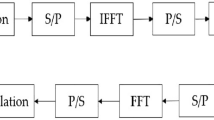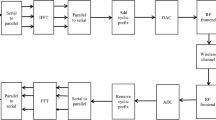Abstract
In this paper a modified version of Saleh-Valenzuela (S-V) channel model has been proposed for Ultra Wide Band (UWB) Orthogonal Frequency Division Multiplexing (OFDM) system and the performance has been estimated. In the proposed model, Poisson process has been modified for ray arrival rate and found that the proposed model is optimum for modeling ray arrival rate as compared to S-V model. Also Nakagami fading distribution has been considered in UWB channel model which suits for time varying multipath radio environment. The performance of the proposed channel model has been statistically analyzed over multiband OFDM by considering frequency domain channel estimation technique. The estimated coefficients have been tracked using Kalman filter technique and found that it gives more accurate prediction of channel coefficients as compared with Least Squares and Minimum Mean Square Estimation channel estimation techniques.
Similar content being viewed by others
References
Fan, X., Leng, B., Zhang, Z., & Guangguo, B. I. (2006). Modified UWB channel estimation. IEEE, 1 1–6.
Maret, L., Siaud, I., & Wideband, U. (2005). MBOA phy layer performance analysis and enhanced issuses ECPS 2005 conference Brest, France.
Turin, W., Jana, R., & Tarokh, V. (2005). Autoregressive modeling of an indoor UWB channel. UWBST, 4, 16–20
Zelenovic V., Wideband U. (2005) Channel modelling. Norwegian University of Science and Technology, Norway
Saleh A., Valenzuela R. (1987) A statistical model for indoor wireless multipath propagation. IEEE JSAC SAC-5(2): 128–137
Molisch , A. F. (2003) Channel models for ultra wideband personal area networks. IEEE Wireless Communications, 1: 14–21
Hayar A.M., Vitetta G.M. (2007) Channel models for ultra-wideband communications: An overview IST network of excellance. NEWCOM 1: 1–5
Liano G., Reing J., Rubio L. (2009) The UWB-OFDM channel analysis in frequency. IEEE Latina America Transactions 7(1): 63–67
Karedal, J., Wyne, S., & Almers, P. (2005). In Fredrik Tufvession, A. F. Moisch (Ed.). Statistical analysis of the UWB channel in industrial enviroment. IEEE Vehicular Technology
Mehbodniya A., Aissa S. (2009) Ultra wideband technologies coexistence in Nakagami-m fading channels. IET Communications, 3(7): 1081–1088
Foersher J. R., Pendergrass M., Moslich A. F. (2006) A channel model for ultra wideband indoor communication. IEEE 7: 31–35
Welch, G., & Bishop, G. (2006). An introduction to the Kalman filter. Chapel Hill: UNC, TR 95-041.
RiazulIslamS.M.Sup Kwak K. (2010) Winner-Hopf interpolation aided Kalman filter-based channel estimation for MB-OFDM UWB systems in time varying dispersive fading channel. ICTACT 2: 191–201
Doukopoulos X. G., Moustakides G. V. (2004) Blind adaptive channel estimation in OFDM systems. IEEE ICC 2004 4: 20–24
Kalman R. E. (1995) A new approach to linear filtering and prediction problems. Transaction of the ASME, (Series D) 82: 32–45
Ozdemir, M. K., & Arslan, H. (2007). Channel estimation for wireless OFDM systems. IEEE Communications, 9(2), 16–48 (2nd quarter).
Tesi, R., & Hämäläinen, M. (2007). In J. Iinatti & V. Hovinen (Eds.), On the performance comparison of different UWB data modulation schemes in AWGN channel in the presence of jamming, IEEE Transactions on Communications.
Coleri, S., Ergen, M., Puri, A., & Bahai, A. (2002). A study of channel estimation in OFDM systems. IEEE.
Doukopoulos X.G., Moustakides G.V. (2004) Blind adaptive channel estimation in OFDM systems. IEEE ICC 2004(4): 20–24
Jie, W., Ke, S., & Liangcheng, J. (2008). Algorithms of channel estimation and tracking in MB-OFDM UWB system. IEEE.
Wang Z., Yan X., Xiaodong W. (2010) A low-complexity and efficient channel estimator for multiband OFDM-UWB sytems. IEEE Transactions on Vehicular Technnology 59(3): 152–159
Zhou W., Lam W.-H. (2010) Channel estimation and data detection over fast fading and dispersive channels. IEEE Transactions on Vehicular Technnology 59(3): 163–167
Liu Y., Peng Q., Shao H. Z., ChenX.F. Wang L. (2009) Blind channel of subcarrier number in multiband OFDM ultra wide band communications system. IEEE proceedings of IC-NIDC 6: 71–75
Barrera M., Betancur L., Navarro A. (2009) A novel SNR estimation algorithm for MB OFDM ultra wide band communications. IEEE 7: 15–21
Hijazi H., Ros L. (2009) Joint data QR-detection and Kalman estimation for OFDM time varying Rayliegh channel complex gains. IEEE Transactions on Communications 58(1): 77–81
Cimini L. J. Jr. (1985) Analysis and simulation of digital mobile channel using orthogonal frequency division multiplexing. IEEE Transactions on Communications 33(7): 665–675
Nam, S.-H., Kim, H. W., Kang, K., Ahn, D.-S., & Lee, H.-J. (2010). Quasi-Newton based Kalman filter channel estimation for OFDM systems. IEEE 2010.
Author information
Authors and Affiliations
Corresponding author
Rights and permissions
About this article
Cite this article
Venkatesh, C., Madheswaran, M. Performance Analysis of Multiband OFDM System Over Ultra Wide Band Channels Using Kalman Filter. Wireless Pers Commun 68, 1121–1134 (2013). https://doi.org/10.1007/s11277-012-0750-z
Published:
Issue Date:
DOI: https://doi.org/10.1007/s11277-012-0750-z




